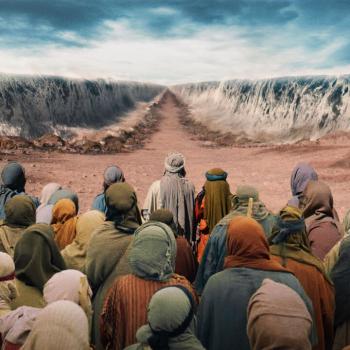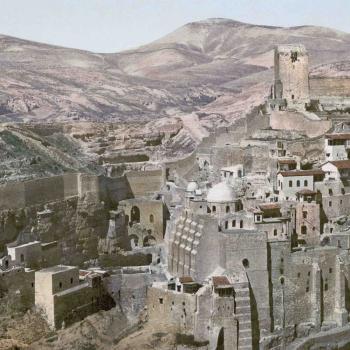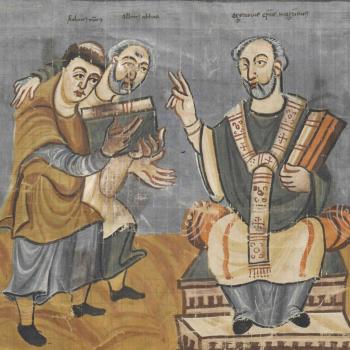I have sketched the political and social meltdown that Palestine suffered in the terrible year of 4 BC. Wars and insurrections were by no means unusual anywhere in the ancient world, and Palestine was no exception. But this particular crisis was unusual in its severity, and several features make it worthy of special notice, especially for anyone interested in Christian origins.
In no particular order:
A NEW LANDSCAPE
The story reminds us how new historically was the world that we encounter in the Gospels. So much of the landscape that Jesus knew had been constructed or reshaped in the time of Herod the Great and his sons. That applies of course to the Temple, but also many cities and fortresses they had built. Tiberias itself dated just from the 20s AD. Herod the Great did not actually found Caesarea, but he vastly improved and refurbished it, and renamed it. He also built the nearby port of Caesarea Maritima.
That remark about novelty applies with special force to the political environment of the Gospels. The kind of alignments and concerns we see there were not age-old, but dated back at most to the first few years BC.
POPULAR RELIGIOUS NATIONALISM GOES MAINSTREAM
The crisis of 4 BC demonstrates a significant development in mass popular politics, and in radical ideologies. Religious nationalism as such was not a new idea at this time, but it was anything but absolute. Jews had often lived under foreign regimes, and they reserved generally happy memories of the Ptolemies in the third century. Divisions and grievances, though, were clearly hardening. Although it began as a domestic civil war, the Maccabean revolt of the 160s was increasingly portrayed as a pure outbreak of revolutionary Jewish nationalism. Such ideas spread in the century after 150 and at Qumran they acquired apocalyptic and even Dualistic dimensions. The poisonous politics of these years escalated those ideas, even though at this point, the rival factions were both Jewish. The total merger of religious and secular offices under the Hasmonean kings ensured that all politics were basically religious.
That is the situation that greets an authentically foreign and non-Jewish regime from the 40s onwards, in the form of the Kittim, the Romans. Like many earlier occupiers, the Romans try their best to respect local religious sensibilities, and they exercise their rule through a local surrogate, namely Herod. Even so, the substance of politics has changed.
Religious/nationalist ideas become vernacular and popular, the preserve of mass movements rather than just theorists or elite factions. There are crowds and mobs waiting to be mobilized. At least in Jerusalem, Demos has arrived on the scene.
We would dearly like to know exactly when this change occurs. Do we just happen to know about those popular upsurges in the first century BC because Josephus recorded them? In that case, perhaps comparable movements had been around for centuries beforehand, but only now came into view. On the other hand, and I think this is far more probable, they really were substantially new. When, for instance, Josephus talks about Herod ridding Galilee of “robbers”, as he did with reference to the 40s BC, were these really criminal bandits, or was that coded official language for political rebels and subversives? Or in fact, is the borderline between bandits and rebels really as clear-cut as we like to think? As later history often shows, bandits are often more political than we assume, while rebels are more in it for the money – taking from the rich, yes, but not necessarily engaging in any further redistributive activities.
We must be careful about categorizing these religious/nationalist movements, and especially about retrojecting ideas from the time of Jesus or the Jewish Revolt. From what we know in later eras, we are very familiar with the image of the self-proclaimed messiah who leads a mob into the wilderness or towards Jerusalem, confident that God’s judgment is about to pour forth and expecting the support of legions of angels. Such characters always have, indeed, existed through history (see the writings of Norman Cohn, in books like In Pursuit of the Millennium). But revolutionary movements, even religious-based ones, need not have such bizarre ideas.
Jewish history offers plenty of examples of more-practical-minded figures, not least the Maccabees themselves. They thought God was on their side, but their revolutions were very much of this world. They succeeded and we call them kings and liberators. Had they failed, we would call them delusional apocalyptic believers or pseudo-messiahs. We should draw the same distinctions with the revolutionaries of the crisis under Archelaus. As modern day movements like ISIS/Daesh remind us, religious-motivated revolutionaries are not necessarily dreamy fantasists aiming for pie in the sky. They can be fiercely practical. Although modern historians sometimes list the three rebel kings of 4 BC as would-be messiahs, Josephus really does not present such a picture: these are populist rebels, without supernatural claims.
MARTYRS
Josephus shows how strongly ideas of martyrdom were already driving political action. Look for instance at his account of the two men who sacrificed their lives in order to take down the eagle at the Temple gate. They proudly admitted to royal officials that they had done it, even thought they faced death on the pyre. Why should they not exult, they asked? Because, they said, after our death, we shall enjoy greater happiness (Jewish War I). After Herod was dead, the two heroes – shall we call them the Two Witnesses? – were mourned extravagantly. “Nor was this mourning of a private nature, but the lamentations were very great, the mourning solemn, and the weeping such as was loudly heard all over the city.” The Loeb translation offers “there were piercing shrieks, a dirge conducted by a conductor, and lamentations with beating of the breast which resounded throughout the city.”
WHY REVOLUTIONS HAPPEN
Josephus’s account of the whole anti-Herod movement is an absolute classic of the genesis and maturing of a revolutionary crisis, with many parallels to comparable events in later eras, for instance in European history. We can divide grievances and stresses into several different layers, from very long term, to long term, to short term, to immediate detonators. Among the long term factors, we should certainly include the heavy burdens of Herod’s rule, notably the massive building program and the taxes it demanded. We see the concatenation of grievances, the growing crisis of the regime, the emergence of ever more militant opposition, and then the resort to open armed violence. It is also clear that, without the heavy-handed Roman intervention, there is no way the Herodian regime could gave survived.
Also interesting in this account is the direct political relevance of the contorted plotting and bloodshed within the royal family. Those court politics may read like soap opera, but they obviously did discredit the regime in the eyes of subjects and other states. That unpopularity helped persuade neighboring rulers to join the Romans in the suppression of the revolt. Court politics had real-world consequences.
LESSONS FOR THE NEXT GENERATION
The crisis under Archelaus would have been acutely in the minds of both authorities and subversives over the following generation. Depending on the point of view, it offered an example to be emulated and improved on, or a terrible warning about how a regime might collapse. Putting these factors together, it really shows why Jesus’s career was so explosive, and the official reaction so swift and decisive.
The Romans and the high priestly elites were absolutely right to be worried about the turbulence of Jerusalem, which so often was central to violence foreign and domestic. Just in the first century BC, we see the massacres of rivals by the Hasmonean king Alexander Jannaeus; the conquest of the city in 63 and 37; and the multiple acts of bloodshed in 4 BC. Each of these instances reputedly claimed multiple thousands of lives. Extrapolating from that rate, Jerusalem in Jesus’s time was about a generation overdue for an explosion.
Another lesson from 4 BC was the extreme difficulty of controlling Jerusalem when fighting an armed and dedicated revolutionary movement. This was hard even for the very well armed and trained Romans, and the garrison came close to destruction.
Among other specifics, the crisis showed the extraordinary sensitivity of Jerusalem at the time of the great pilgrim feasts, when the city filled with many thousands of outside visitors, many filled with religious zeal. Passover and Pentecost were both critical movements of insurrection during the crisis of 4 BC.
The crisis helps us understand the peculiar sensitivity of Galilee as a source of disorder. Josephus particularly singles out the pilgrims ho flooded the city from Galilee and Idumea, and their turbulent character. Galilee also produced in Judas one of the first known revolutionary “kings,” whose field of operation was Sepphoris, near Nazareth. Presumably, his origins were not far away from that center.
If we want to understand what Roman or priestly authorities were most afraid of when they confronted figures like John the Baptist or Jesus, we need only turn back to the pseudo-kings of the earlier crisis. Because of the limitations of our sources, we don’t know whether such figures had been common in earlier eras, but only in 4 BC do we see a gaggle of such upstart kings, likely with messianic pretensions. That might suggest that they were truly a new phenomenon.
I have already described how messianic ideas were developing and maturing in the first and second centuries BC, at least among priestly and intellectual circles. As with so much else, the revolutionary upsurge of 4 BC brought these ideas to a mass public.
FROM VARUS’S WAR TO THE GREAT JEWISH REVOLT
Josephus’s account suggests that the Zealot movement was absolutely rooted in the revolutionary violence under Herod the Great and Archelaus. The key figure he identifies was Judas the Galilean, whose father was executed under Herod the Great. Judas’s own revolt followed the crisis under Archelaus by just a decade, and follows closely form popular risings at that time. In turn, Judas’s family carried on the tradition right through to the Jewish revolt and the cataclysm of the 60s AD. We are looking here at deep continuities.
The more you know about the actual rising of the 60s, the more familiar the earlier event looks, and the more striking the several near-misses. In 4 BC, for instance, unlike 66 AD, the Roman garrison survives and the relieving legion is not destroyed – but matters could have worked out differently. The earlier revolt comes close to being a major Roman crisis.
In summary, the crisis of 4 BC does seem a critical moment in political and religious history. I just wish we had a better and more efficient name for it.
















